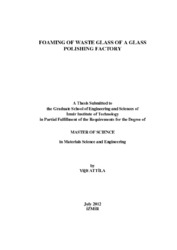Please use this identifier to cite or link to this item:
https://hdl.handle.net/11147/3509Full metadata record
| DC Field | Value | Language |
|---|---|---|
| dc.contributor.advisor | Taşdemirci, Alper | - |
| dc.contributor.author | Attila, Yiğit | - |
| dc.date.accessioned | 2014-07-22T13:51:42Z | - |
| dc.date.available | 2014-07-22T13:51:42Z | - |
| dc.date.issued | 2012 | - |
| dc.identifier.uri | http://hdl.handle.net/11147/3509 | - |
| dc.description | Thesis (Master)--Izmir Institute of Technology, Materials Science and Engineering, Izmir, 2012 | en_US |
| dc.description | Includes bibliographical references (leaves: 66-69) | en_US |
| dc.description | Text in English; Abstract: Turkish and English | en_US |
| dc.description | xi, 69 leaves | en_US |
| dc.description | Full text release delayed at author's request until 2015.07.23 | en_US |
| dc.description.abstract | The foaming behavior of a glass powder, a residue from a window glass polishing factory in Bursa, was investigated at the temperatures between 700-950°C. As-received glass powder composition, 72.76% SiO2, 11.18% Na2O, 11.31% CaO, 1.74% MgO and 1.61% Al2O3, was well matched with that of soda lime window glass. The expansion of the glass powder compacts started at a characteristic temperature of 690-700 °C and reached a maximum volumetric expansion values at about 866-877 °C. The maximum volume expansion and foam density varied between 700-772% and 0.378-0.206 g/cm3, respectively. The foaming of the compact at 750 °C yielded only crystalline phase of quartz, as the foaming temperature increased over 750 °C, wollastonite and diopsite crystals formed The compressive strength of the foams ranged between 1.9 and 4 MPa and the thermal conductivity between 0.048-0.079 W/K m. Both collapse and plateau stresses increased with increasing relative density, while heating rate was found to be not affect the collapse and plateau stresses. The foamed glass samples showed the mechanical behavior similar to open cell foams. This was attributed to the thicker cell edges and thinner cell walls leading to higher glass material accumulation on the cell edges. The self-foaming behavior of the studied waste glass powder was attributed to the organic compounds within the boron oil which was used as a coolant in the polishing operations. | en_US |
| dc.language.iso | en | en_US |
| dc.publisher | Izmir Institute of Technology | en_US |
| dc.rights | info:eu-repo/semantics/openAccess | en_US |
| dc.subject.lcsh | Foamed materials | en |
| dc.subject.lcsh | Cellular glass | en |
| dc.title | Foaming of Waste Glass of a Glass Polishing Factory | en_US |
| dc.type | Master Thesis | en_US |
| dc.institutionauthor | Attila, Yiğit | - |
| dc.department | Thesis (Master)--İzmir Institute of Technology, Materials Science and Engineering | en_US |
| dc.relation.publicationcategory | Tez | en_US |
| dc.identifier.wosquality | N/A | - |
| dc.identifier.scopusquality | N/A | - |
| item.languageiso639-1 | en | - |
| item.grantfulltext | open | - |
| item.fulltext | With Fulltext | - |
| item.openairecristype | http://purl.org/coar/resource_type/c_18cf | - |
| item.openairetype | Master Thesis | - |
| item.cerifentitytype | Publications | - |
| Appears in Collections: | Master Degree / Yüksek Lisans Tezleri | |
Files in This Item:
| File | Description | Size | Format | |
|---|---|---|---|---|
| 438200.pdf | MasterThesis | 3.34 MB | Adobe PDF |  View/Open |
CORE Recommender
Page view(s)
306
checked on Jun 16, 2025
Download(s)
122
checked on Jun 16, 2025
Google ScholarTM
Check
Items in GCRIS Repository are protected by copyright, with all rights reserved, unless otherwise indicated.